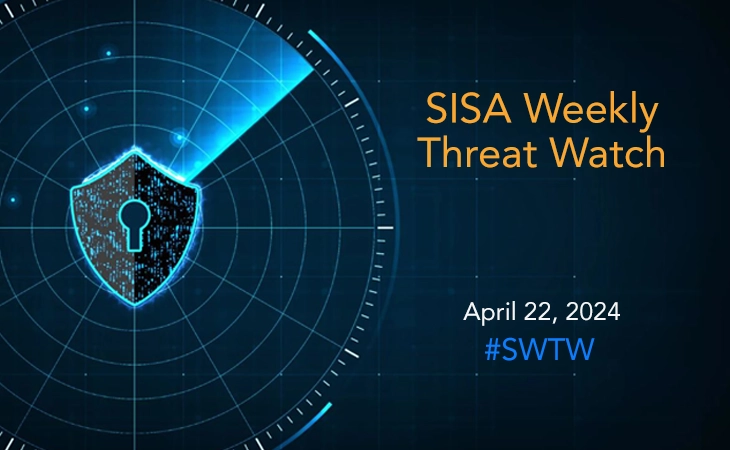Home » Leadership Lens: Cybersecurity Predictions and Trends for 2024
Leadership Lens: Cybersecurity Predictions and Trends for 2024
Share on

2023 has been a whirlwind of a year! As I journeyed around the world and SISA immersed itself in various global events, we’ve had a plethora of eye-opening and thought-provoking chats with security experts everywhere. These discussions, combined with our in-depth market analysis and the insights gleaned from our unique in-house expertise, have deeply informed our perspective on the cybersecurity landscape. And let me tell you, our predictions for the future aren’t just crystal ball gazes; they’re grounded in solid evidence from our forensic investigations and internal research and intelligence teams. We’re looking at a future that’s brimming with both daunting challenges and exciting opportunities.
Now, as we venture into 2024, there are three major trends I believe will significantly influence the cybersecurity narrative and dominate tech discussions:
- AI as a Two-Way Street: Artificial Intelligence will be a game-changer, wielded by both the good guys and the bad. We’re talking about cybercriminals using AI for high-tech tricks like deepfakes and automated attacks, which makes distinguishing between what’s real and what’s not even harder. But it’s not all doom and gloom! Expect AI algorithms to deliver real-time threat analysis in 2024, offering quicker, more precise responses to cyber threats. Machine Learning will evolve to independently tweak and improve security measures, reducing the need for manual updates.
- Digital Echoes of Geopolitical Strife: The cyber realm is becoming a new battlefield for international conflicts. The distinction between national cyber forces and criminal hackers is getting fuzzier, and this will likely lead to intricate cyber conflicts with worldwide repercussions in 2024. We can anticipate more frequent and sophisticated cyberattacks, especially those backed by nations, targeting crucial sectors. These attacks could disrupt vital services, steal sensitive data, or compromise key systems. To counter this, expect to see stronger collaboration across sectors and nations, as they join forces to tackle these advanced cyber threats.
- Cyberattacks: A Growing Storm: Despite our hopes, cyberattacks aren’t slowing down. In fact, the landscape for such attacks is expanding rapidly. 2024 will likely see a surge in attacks targeting ransomware APIs, cloud services, edge computing, and IoT devices. This isn’t just a technical issue; it calls for strategic, adaptable planning. Expect to see governments and regulatory bodies introduce stricter regulations on data security and privacy, especially for critical infrastructure sectors like healthcare and finance. This could involve mandatory reporting of breaches, stricter data protection laws, and increased oversight of cloud service providers and IoT device manufacturers.
And there’s more! This year, cybersecurity is set to become a top strategic priority. The role of the Chief Information Security Officer (CISO) will evolve from being just a firefighting, compliance-enforcing figure to a key player in business strategy and driving competitive advantages through cybersecurity. This shift will focus on proactive threat anticipation, not just reacting to incidents.
Besides these, there are several specialized trends on the horizon for 2024. The team at SISA is excited to share with you the key developments we expect will shape the cybersecurity landscape in the current year.
Growing Threats, Shifting Dynamics
“The ransomware landscape is transforming rapidly, and it’s starting to mirror the dynamics of a startup ecosystem. We’re seeing different groups emerge as the ‘unicorns,’ the disruptors, and the fresh faces in the field. Looking ahead, we can expect ransomware attacks to not only continue but also to scale up significantly, aiming for heftier profits.
However, there’s a twist in the tale. Government crackdowns and law enforcement actions are likely to dismantle some of the bigger ransomware groups. With this, we’re anticipating the rise of smaller, more covert groups. These new players are popping up globally, marking an evolution towards more strategically and technically advanced ransomware operators. The future looks like it will be marked by more sophisticated ransomware attacks, potentially leading to larger financial demands.
On another crucial front, there’s a significant and much-needed shift happening in IoT security standards. As IoT devices become increasingly integrated into essential systems – think Smart Cities – and start leveraging cutting-edge technologies like 5G and satellite connectivity, the industry is waking up to the critical need for solid cybersecurity measures. This isn’t just about implementing advanced encryption or stringent security protocols; it’s also about setting up continuous monitoring and real-time threat detection systems. Here’s where AI and ML step in, offering powerful tools to bolster our defenses in this ever-evolving landscape.”
– Renju Varghese, VP – Forensics and R&D, SISA
Embracing Integrated Cybersecurity with MXDR
“In 2024, enterprises are standing at a pivotal moment when it comes to cybersecurity. The core issue they’re grappling with is the siloed nature of their security tools. The temptation to pick the ‘best of breed’ solutions from various vendors has resulted in a fragmented security setup. This patchwork approach is riddled with integration challenges and runs the risk of missing critical alerts. It’s a scenario where the security landscape has become disjointed, leading to a surge in duplicate alerts and a ballooning workload for security teams, without a corresponding boost in actual security.
Enterprises are now at a crucial juncture, reevaluating this path of accumulating multiple tools that offer diminishing returns. The shift we’re expecting to see is a strategic pivot towards a more consolidated approach. This approach will streamline threat detection and management, moving away from the clutter of disparate tools.
This is where solutions like Managed Extended Detection and Response (MXDR) come into play. They’re poised to catalyse a paradigm shift in how organizations handle cyber risk management. MXDR has the potential to revolutionize the field by effectively correlating alerts across an organization’s entire IT infrastructure. By providing a more holistic view, it enables better, faster decision-making and a more robust defence against the evolving landscape of cyber threats.”
– Mahendran Chandramohan, VP – MDR Solution, SISA
Global Regulatory Surge
“2024 is shaping up to be a year of intensified regulation, especially in the realm of AI, and CISOs need to gear up for this wave. We’re witnessing a growing focus on AI regulation, spanning both sector-specific and broader rules that are set to impact almost every industry. Take the European Union, for example, where they’ve introduced regulations like the EU Artificial Intelligence Act, which adopts a risk-based approach to AI usage. Across the pond, the United States is also stepping up its game in AI regulation. The Biden administration’s executive order to evaluate AI’s safety and security is a clear indicator of this trend.
But this isn’t just a European or American phenomenon. It’s truly global, with over 37 countries actively proposing AI-related legal frameworks. As governments ramp up their regulatory efforts, CISOs and other industry leaders are facing a new challenge. They’ll need to tweak and adapt their cybersecurity strategies to successfully navigate this increasingly complex regulatory landscape. Ensuring the security of customer data and maintaining compliance in this rapidly evolving regulatory environment will be key priorities for CISOs worldwide.”
– Sachin Sawant, VP – Compliance & Testing Services, SISA
Proactive Governance and the AI Security Equation
“The landscape of data privacy and security regulations is evolving rapidly, and 2024 is set to be a year where early data governance becomes not just a best practice, but a compliance imperative. Amidst this backdrop, the ‘Shift Left’ approach to integrating data governance measures earlier in the data lifecycle will be critical to safeguard sensitive information and enhance overall data quality from the get-go.
The widespread adoption of AI and Large Language Models (LLMs) is adding another layer of complexity to this scenario. While these technologies offer immense benefits, they also bring heightened risks related to data security. Organizations find themselves walking a tightrope, trying to leverage the advantages of AI and LLMs while simultaneously mitigating risks and ensuring responsible usage. To navigate this delicate balance, comprehensive data governance frameworks are becoming indispensable. These frameworks encompass a range of strategies: from data classification and robust access controls to anonymization techniques, regular audits, and strict regulatory compliance.”
– Prabhu Narayanan, VP – Data Protection & Governance, SISA
Cybersecurity Talent Shortfall
“The cyber talent drought shows no signs of quenching, potentially jeopardizing over half of all major cyber-attacks by 2025. Organizations scrambling for qualified security professionals will have to think beyond traditional recruitment, forging partnerships and actively cultivating talent through expanded training avenues.
A key solution is to enhance training initiatives, focusing not only on the quantity but also on the quality of the programs. Organizations will need to prioritize and invest in rigorous, industry-aligned programs built on cutting-edge methodologies and delivered by experienced instructors. Accredited certifications, recognized both nationally and internationally, will provide a crucial benchmark for skill and proficiency, assuring businesses hire defenders equipped to navigate the increasingly complex cybersecurity challenges.”
– Dr Rajan, VP – SISA Institute
As we conclude our insights on the cybersecurity landscape of 2024, it’s also crucial to address the impact of tightened security budgets. Economic uncertainties are leading organizations to scrutinize their security expenditures more closely. CEOs, CSOs, and CISOs are increasingly collaborating to optimize budget allocations, focusing on risk prioritization and proactive security investments. This trend underscores the importance of reassessing risk assessments and involving all stakeholders in budgetary decisions. Amidst these constraints, it’s essential for security teams to refocus on core cybersecurity fundamentals: enforcing strong authentication, hardening systems, and maintaining vigilant security monitoring and vulnerability management. These steps are key to safeguarding data and ensuring safety in both physical and digital spaces, particularly when navigating budget limitations.
 USA
USA India
India APAC
APAC Middle East
Middle East Global
Global

 Facebook
Facebook Linkedin
Linkedin  Twitter
Twitter Youtube
Youtube








